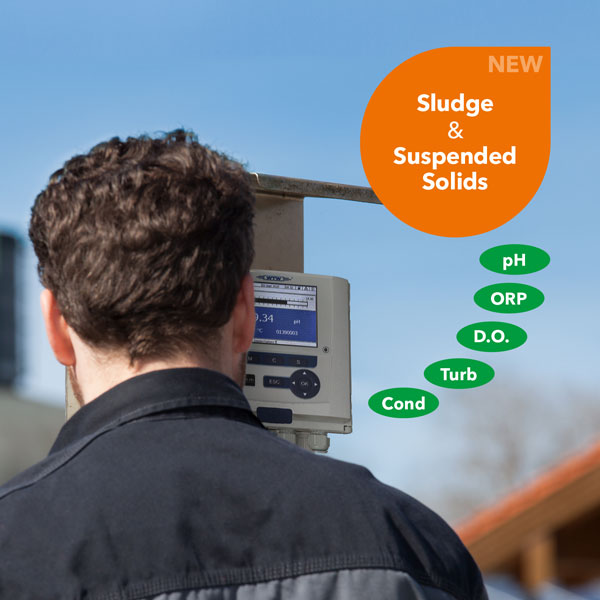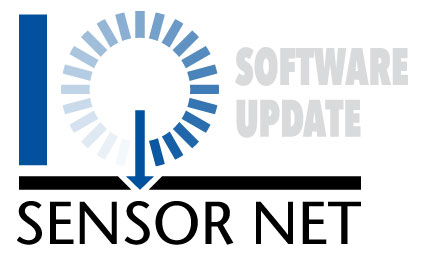
The current software update now also enables the connection of the IFL 700 IQ sludge level sensor to the IQ SENSOR NET single measuring point of the 281 series.
Increasingly frequent heavy rainfall events and rising precipitation peaks result in high hydraulic loading and overloading for wastewater treatment plants. This increases the risks of technical damage to the plant, disruption of biological treatment performance or sludge runoff. To avoid such damage, continuous sludge level monitoring - in addition to emergency drains in the sewer system and rainwater retention basins - is becoming increasingly important. For this, the sludge level sensor IFL 700 IQ is the ideal solution, also regarding the prevention of sludge drive.
Softwareupdate
Due to our softwareupdate it is now possible to measure solids and the sludge level with the DIQ/S 281 in addition to pH/redox, dissolved oxygen, turbidity, and conductivity.

Why does it make sense
to measure the sludge level in the wastewater treatment plant?
 Heavy rainfall challenges wastewater treatment plants
Heavy rainfall challenges wastewater treatment plants
An increasing number of starting rainfall events, but above all higher precipitation peaks, have enormous consequences for the sewer network and thus also for the wastewater treatment plants. The resulting combined sewage can be temporarily stored in stormwater overflow basins in certain quantities, but even this has its limits. Therefore, the hydraulic peak loads of the wastewater treatment plants come more and more into focus.
Risk of sludge drift
A possible and relatively fast occurring consequence of such peak loads is sludge drift. The hydraulic load leads to a distribution of the sludge in the entire sedimentation basin. The sludge thus diluted can thus no longer settle to the bottom of the basin and will eventually be driven off. The resulting loss of biomass reduces the cleaning performance of the plant. In addition, the effluent values increase and may even exceed the permitted limits.
The risk of sludge drift can affect wastewater treatment plants of any size. Small plants can absorb hydraulic peaks more poorly, but in larger plants, due to the volume, a drift would have enormous consequences, both for the receiving water and for the operation of the plant.
Continuous sludge level monitoring
To counteract this risk, continuous monitoring of the sludge level is becoming increasingly important. Compared to punctual and possibly manual measurements, continuous measurement provides objective information about the conditions prevailing in the basin at any time. In addition, the measured values can be processed on the PLC and enable automatic control and regulation of the sludge level.
These include, for example, early additional sludge removal or increasing the power of the return sludge pump if there is a risk of sludge drift.
WTW offers with the IFL 700 IQ a precise, reliable and low-maintenance sludge level sensor for primary and secondary clarification. The sensor is immediately ready for use after a few settings (immersion depth, basin depth) and then provides not only the measured value but also a detailed display of the echo profile, thus making the conditions in the basin visible. Unwanted signals (e.g. fixtures or scrapers) can be masked out, and the automatic and non-contact scraper removes disturbing air bubbles and algae growth.
 Product page
Product page
More information about the IFL 700 IQ sensor can be found on the product details page.
Downloads
Download the product flyer of the IFL 700 IQ as a PDF
(999100US, English, approx. 600 KB)
Download the product flyer of the IQ SENSOR NET System 281 as a PDF
(999148US, English, approx. 600 KB)
 Download data sheet D2.17 to the digital sludge level sensor IFL 700 IQ as PDF
Download data sheet D2.17 to the digital sludge level sensor IFL 700 IQ as PDF
(999240US, English, approx. 100 KB)
 Download data sheet D1.09 to the IQ SENSOR NET system 281 as a PDF
Download data sheet D1.09 to the IQ SENSOR NET system 281 as a PDF
(999215US, English, approx. 100 KB)
Tech note on continuous monitoring against sludge drift
using the IFL 700 IQ sensor